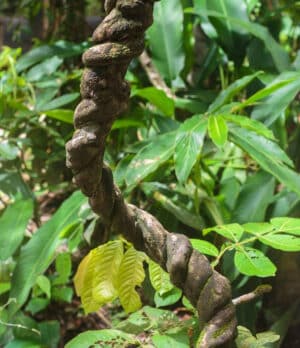- General information
- Growing Banisteriopsis caapi
- Ayahuasca and shamanism
- Precautionary measures
- Conclusion
HERE you will find our selection of Banisteriopsis and similar. seeds!
Banisteriopsis caapi
Banisteriopsis caapi is a plant that has been used for centuries by indigenous peoples in South America for ritual and medicinal purposes. In this article, I will explore the different aspects of growing Banisteriopsis caapi and the use of ayahuasca, a psychoactive substance extracted from this plant.
1. general
Banisteriopsis caapi, also known as yagè or ayahuasca vine, is a climbing plant that is common in the rainforests of the Amazon. It belongs to the Malpighiaceae family and contains a number of psychoactive alkaloids, including harmine, harmaline and tetrahydroharmine. These alkaloids are responsible for the hallucinogenic effects of ayahuasca.
2. grow Banisteriopsis caapi
Banisteriopsis caapi can be grown from seeds or cuttings. Growing this plant requires specific conditions to ensure optimum growth. The plant prefers a moist and shady location with well-drained soil. The pH value of the soil should be slightly acidic, ideally between 5.5 and 6.5.
To grow Banisteriopsis caapi successfully, it is important to water the plants regularly and protect them from strong winds or frost. The plant can reach a height of up to 30 meters and therefore needs enough space to grow. It is advisable to attach the plant to a stable structure such as a tree or support trellis to ensure healthy growth.
3. ayahuasca and shamanism
Ayahuasca is a psychoactive substance made from a combination of Banisteriopsis caapi and other plants, such as chacruna (Psychotria viridis). This combination produces a strong psychedelic effect that is used by indigenous peoples for ritual and medicinal purposes.
In shamanism, ayahuasca is often considered a sacred medicine and is used by shamans in ceremonies to facilitate spiritual experiences and healing. The effects of ayahuasca can vary greatly, ranging from intense visual hallucinations to deep spiritual insights. It is important to only take ayahuasca under the guidance of an experienced shaman, as the experience can be potentially intense and challenging.
4. precautionary measures
The use of ayahuasca requires caution and respect. It is important to be aware of the potential risks and side effects and to ensure that you are physically and mentally ready to undergo the experience. Some possible side effects of ayahuasca include nausea, vomiting and diarrhea. It is also important to note that ayahuasca can interact with certain medications, especially antidepressants. It is advisable to consult a doctor before taking ayahuasca to check for possible interactions.
In addition, it is important to take ayahuasca only in a safe and trustworthy environment, under the supervision of an experienced shaman or qualified person. The ayahuasca experience can be intense and require appropriate support and care.
5. conclusion
Banisteriopsis caapi is a fascinating plant with a long history of use in traditional cultures. Its cultivation requires specific conditions to be successful, and the use of ayahuasca requires caution and respect. However, exploring and experiencing ayahuasca can lead to deep spiritual insights and personal growth. If one is interested in growing Banisteriopsis caapi and using ayahuasca, it is important to educate oneself thoroughly and seek the support of experienced individuals.
Note: The information in this article is for informational purposes only and is not intended to replace the advice of a physician or other healthcare professional. Always consult a doctor before using any new herbs or supplements. Furthermore, you should always check whether certain plants are permitted in your country before growing them.











